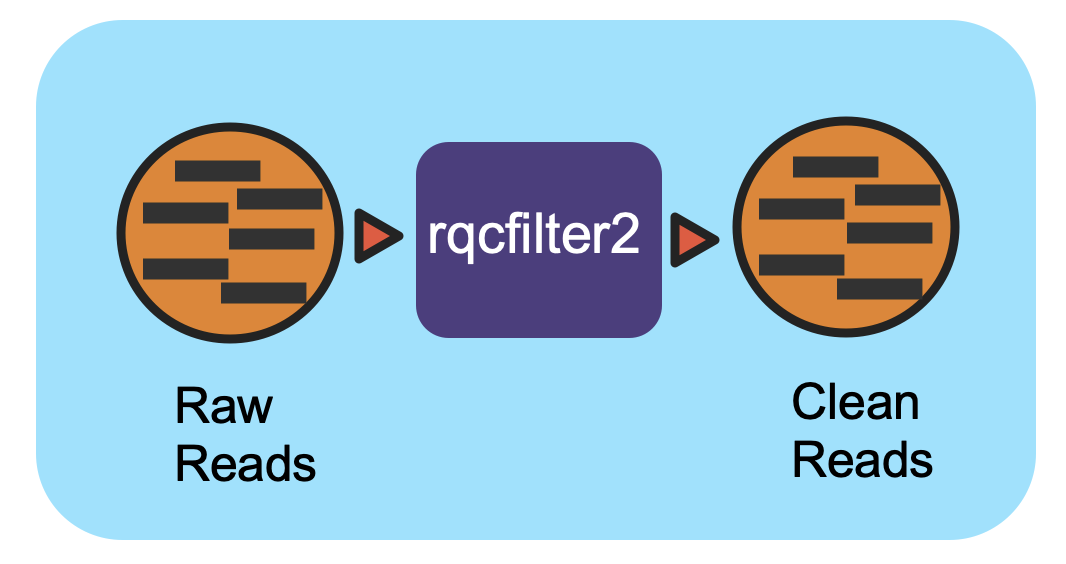Reads QC Workflow (v1.0.1)

Workflow Overview
This workflow utilizes the program “rqcfilter2” from BBTools to perform quality control on raw Illumina reads. The workflow performs quality trimming, artifact removal, linker trimming, adapter trimming, and spike-in removal (using BBDuk), and performs human/cat/dog/mouse/microbe removal (using BBMap).
Workflow Availability
The workflow from GitHub uses all the listed docker images to run all third-party tools. The workflow is available in GitHub: https://github.com/microbiomedata/ReadsQC; the corresponding Docker image is available in DockerHub: https://hub.docker.com/r/microbiomedata/bbtools.
Requirements for Execution
(recommendations are in bold)
WDL-capable Workflow Execution Tool (Cromwell)
Container Runtime that can load Docker images (Docker v2.1.0.3 or higher)
Hardware Requirements
Disk space: 106 GB for the RQCFilterData database
Memory: >40 GB RAM
Workflow Dependencies
Third party software (This is included in the Docker image.)
BBTools v38.90 (License: BSD-3-Clause-LBNL)
Requisite database
The RQCFilterData Database must be downloaded and installed. This is a 106 GB tar file which includes reference datasets of artifacts, adapters, contaminants, the phiX genome, and some host genomes.
The following commands will download the database:
mkdir refdata
wget http://portal.nersc.gov/dna/microbial/assembly/bushnell/RQCFilterData.tar
tar -xvf RQCFilterData.tar -C refdata
rm RQCFilterData.tar
Sample dataset(s)
Zymobiomics mock-community DNA control (SRR7877884); the original gzipped dataset is ~4 GB.
Note
If the input data is paired-end data, it must be in interleaved format. The following command will interleave the files, using the above dataset as an example:
paste <(zcat SRR7877884_1.fastq.gz | paste - - - -) <(zcat SRR7877884_2.fastq.gz | paste - - - -) | tr '\t' '\n' | gzip -c > SRR7877884-int.fastq.gz
For testing purposes and for the following examples, we used a 10% sub-sampling of the above dataset: SRR7877884-int-0.1.fastq.gz. This dataset is already interleaved.
Inputs
A JSON file containing the following information:
the path to the database
the path to the interleaved fastq file (input data)
the path to the output directory
(optional) parameters for memory
(optional) number of threads requested
An example input JSON file is shown below:
{
"jgi_rqcfilter.database": "/path/to/refdata",
"jgi_rqcfilter.input_files": [
"/path/to/SRR7877884-int-0.1.fastq.gz "
],
"jgi_rqcfilter.outdir": "/path/to/rqcfiltered",
"jgi_rqcfilter.memory": "35G",
"jgi_rqcfilter.threads": "16"
}
Note
In an HPC environment, parallel processing allows for processing multiple samples. The “jgi_rqcfilter.input_files” parameter is an array data structure. It can be used for multiple samples as input separated by a comma (,). Ex: “jgi_rqcfilter.input_files”:[“first-int.fastq”,”second-int.fastq”]
Output
A directory named with the prefix of the FASTQ input file will be created and multiple output files are generated; the main QC FASTQ output is named prefix.anqdpht.fastq.gz. Using the dataset above as an example, the main output would be named SRR7877884-int-0.1.anqdpht.fastq.gz. Other files include statistics on the quality of the data; what was trimmed, detected, and filtered in the data; a status log, and a shell script documenting the steps implemented so the workflow can be reproduced.
Part of an example output JSON file is shown below:
SRR7877884-int-0.1
|-- SRR7877884-int-0.1.anqdpht.fastq.gz
|-- filterStats.txt
|-- filterStats.json
|-- filterStats2.txt
|-- adaptersDetected.fa
|-- reproduce.sh
|-- spikein.fq.gz
|-- status.log
|-- ...
Below is an example of all the output directory files with descriptions to the right.
FileName |
Description |
|---|---|
SRR7877884-int-0.1.anqdpht.fastq.gz |
main output (clean data) |
adaptersDetected.fa |
adapters detected and removed |
bhist.txt |
base composition histogram by position |
cardinality.txt |
estimation of the number of unique kmers |
commonMicrobes.txt |
detected common microbes |
file-list.txt |
output file list for rqcfilter2.sh |
filterStats.txt |
summary statistics |
filterStats.json |
summary statistics in JSON format |
filterStats2.txt |
more detailed summary statistics |
gchist.txt |
GC content histogram |
human.fq.gz |
detected human sequence reads |
ihist_merge.txt |
insert size histogram |
khist.txt |
kmer-frequency histogram |
kmerStats1.txt |
synthetic molecule (phix, linker, lamda, pJET) filter run log |
kmerStats2.txt |
synthetic molecule (short contamination) filter run log |
ktrim_kmerStats1.txt |
detected adapters filter run log |
ktrim_scaffoldStats1.txt |
detected adapters filter statistics |
microbes.fq.gz |
detected common microbes sequence reads |
microbesUsed.txt |
common microbes list for detection |
peaks.txt |
number of unique kmers in each peak on the histogram |
phist.txt |
polymer length histogram |
refStats.txt |
human reads filter statistics |
reproduce.sh |
the shell script to reproduce the run |
scaffoldStats1.txt |
detected synthetic molecule (phix, linker, lamda, pJET) statistics |
scaffoldStats2.txt |
detected synthetic molecule (short contamination) statistics |
scaffoldStatsSpikein.txt |
detected skipe-in kapa tag statistics |
sketch.txt |
mash type sketch scanned result against nt, refseq, silva database sketches. |
spikein.fq.gz |
detected skipe-in kapa tag sequence reads |
status.log |
rqcfilter2.sh running log |
synth1.fq.gz |
detected synthetic molecule (phix, linker, lamda, pJET) sequence reads |
synth2.fq.gz |
detected synthetic molecule (short contamination) sequence reads |
Version History
1.0.1 (release date 02/16/2021; previous versions: 1.0.0)
Point of contact
Original author: Brian Bushnell <bbushnell@lbl.gov>
Package maintainer: Chienchi Lo <chienchi@lanl.gov>